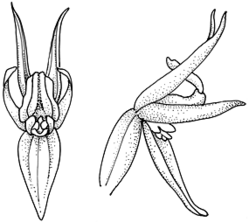Common name: Forest Leek-orchid
Prasophyllum sylvestre R.J.Bates & D.L.Jones APNI* 
Description: Terrestrial herb, to 50 cm high.
Leaf to 40 cm long.
Inflorescence usually < 30-flowered, widely spaced. Flowers pale green, pinkish to red-brown, faintly fragrant. Dorsal sepal to 10 mm long, ovate to lanceolate, acuminate. Lateral sepals to 10 mm long, united at least halfway, the free tips divergent. Lateral petals to 7.5 mm long, linear to lanceolate or sickle-shaped. Labellum with a short claw, lamina to 9 mm long and 3 mm wide, obovate to oblong, with an elongated tip when flattened; in living flowers the upper half of the lamina is reflexed so it is obliquely erect or protrudes between the lateral sepals, margins weakly crisped to barely undulating. Callus plate lanceolate to acutely triangular, yellow-green, rarely purplish, warty, extending almost to the tip of the lamina. Column wings linear, sigmoid; rostellum length equal to or shorter than the wings.
Flowering: October–January, usually after disturbance or burning.
Distribution and occurrence: Grows in fertile soils in coastal forest and woodland; south from Batemans Bay district.
NSW subdivisions: SC
Other Australian states: Vic. S.A.
Text by P. Bernhardt & R. R. Rowe
Taxon concept: Flora of NSW 4 (1993)
APNI* Provides a link to the Australian Plant Name Index (hosted by the Australian National Botanic Gardens) for comprehensive bibliographic data
***The AVH map option provides a detailed interactive Australia wide distribution map drawn from collections held by all major Australian herbaria participating in the Australian Virtual Herbarium project.
|


